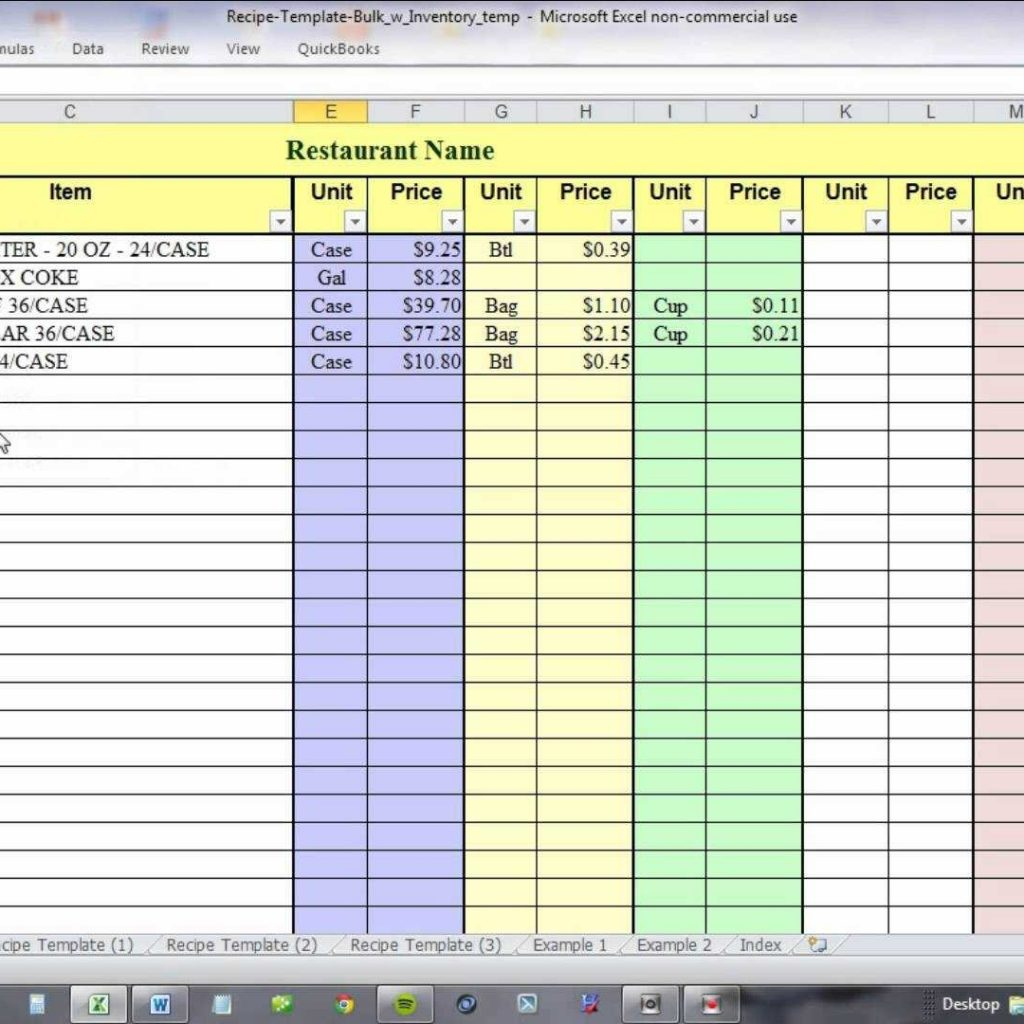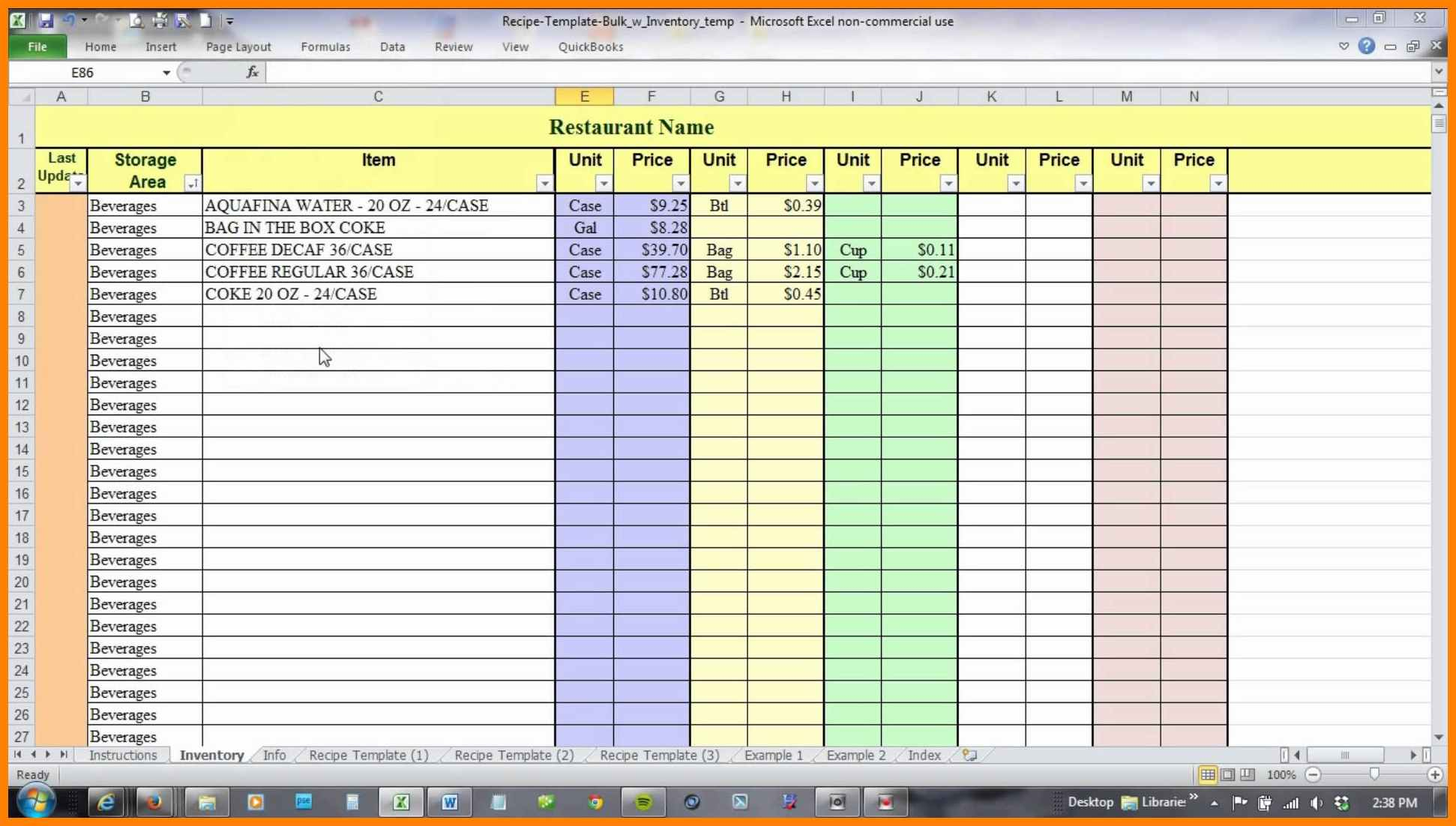In the culinary world, profitability hinges on understanding the intricacies of recipe costing. With the advent of digital tools like Excel, recipe costing has become more accessible than ever. This comprehensive guide will empower you with the knowledge and resources to create a robust recipe costing template in Excel, ensuring accurate pricing, informed decision-making, and optimized profitability.
Whether you’re a seasoned chef, a restaurant manager, or an aspiring food entrepreneur, this guide will provide you with a step-by-step roadmap to mastering recipe costing. By leveraging the power of Excel, you can streamline your operations, enhance your menu offerings, and drive your culinary business towards success.
Introduction to Costing
Costing is the process of determining the cost of a product or service. In the food and beverage industry, recipe costing is essential for profitability and efficiency. It allows businesses to track the cost of each ingredient used in a recipe, as well as the total cost of producing a dish.
Using a recipe costing template in Excel can streamline the costing process and provide several benefits. It can help businesses:
Benefits of using a Recipe Costing Template
- Quickly and easily calculate the cost of recipes.
- Compare the cost of different recipes.
- Track ingredient usage and costs.
- Make informed decisions about pricing and menu planning.
- Control food costs and improve profitability.
Components of a Recipe Costing Template

A recipe costing template is a crucial tool for accurately determining the cost of producing a dish. It provides a structured framework for capturing all the necessary information to calculate the total cost of a recipe.
Essential Components
- Ingredient list: A complete list of all ingredients used in the recipe, including their respective measurements or weights.
- Ingredient quantities: The specific amount of each ingredient required to prepare the dish.
- Ingredient costs: The unit cost of each ingredient, typically sourced from vendor invoices or market prices.
- Labor costs: The cost associated with preparing the dish, including the chef’s time, any additional staff involved, and any specialized equipment required.
- Overhead costs: Fixed costs that contribute to the overall operation of the kitchen, such as rent, utilities, insurance, and depreciation.
Creating a Recipe Costing Template in Excel
Creating a recipe costing template in Excel can help you track the cost of your recipes and make informed decisions about your food and beverage operations. Here’s a guide to help you create a template that meets your needs:
Formatting the Spreadsheet
Start by creating a new spreadsheet in Excel. Format the spreadsheet with the following columns:
- Ingredient
- Unit
- Quantity
- Unit Cost
- Ingredient Cost
Inputting Ingredient Data
In the Ingredient column, list all the ingredients used in the recipe. In the Unit column, specify the unit of measurement for each ingredient (e.g., ounces, pounds, cups). In the Quantity column, enter the amount of each ingredient used.
Calculating Ingredient Costs
In the Unit Cost column, enter the cost per unit for each ingredient. The Ingredient Cost column will automatically calculate the cost of each ingredient by multiplying the Quantity by the Unit Cost.
Calculating Labor Costs
To calculate labor costs, you’ll need to determine the hourly wage of your staff and the time it takes to prepare the recipe. Enter this information in a separate section of the spreadsheet.
Calculating Overhead Costs
Overhead costs include expenses like rent, utilities, and equipment depreciation. Estimate these costs and enter them in a separate section of the spreadsheet.
Calculating Total Recipe Cost
To calculate the total recipe cost, add the ingredient costs, labor costs, and overhead costs. The result will be the total cost of producing one unit of the recipe.
Using a Recipe Costing Template
A recipe costing template is a valuable tool that can help you manage your food costs effectively. By using a template, you can easily track recipe costs over time, compare costs between different recipes, identify areas for cost savings, and make informed decisions about menu pricing.
Tracking Recipe Costs Over Time
Tracking recipe costs over time allows you to monitor changes in ingredient prices and identify trends. This information can be used to adjust recipes, negotiate with suppliers, and make informed decisions about menu pricing.
Comparing Costs Between Different Recipes
Comparing costs between different recipes can help you identify which recipes are most profitable and which ones need to be revised. This information can be used to make decisions about which recipes to feature on your menu and which ones to discontinue.
Identifying Areas for Cost Savings
A recipe costing template can help you identify areas where you can save money on food costs. By analyzing the cost of each ingredient, you can determine which ingredients are the most expensive and which ones can be replaced with less expensive alternatives.
Making Informed Decisions About Menu Pricing
A recipe costing template can help you make informed decisions about menu pricing. By knowing the cost of each recipe, you can set prices that are both profitable and competitive.
Benefits of Using a Free Recipe Costing Template
Utilizing a free recipe costing template offers numerous advantages for businesses in the food industry. Not only does it provide accessibility and affordability, but it also streamlines the costing process, enhancing accuracy and reliability.
Accessibility and Affordability
A free recipe costing template eliminates the need for expensive software or consulting services, making it accessible to businesses of all sizes. This cost-effective solution allows even small-scale operations to implement a structured costing system.
Time Savings
Automating the costing process with a template saves businesses significant time and effort. By providing pre-defined formulas and calculations, the template streamlines data entry and analysis, allowing users to quickly and efficiently determine the cost of their recipes.
Accuracy and Reliability
Free recipe costing templates are often developed by industry experts, ensuring accuracy and reliability in the calculations. They utilize industry-standard formulas and best practices, minimizing the risk of errors and providing confidence in the cost data generated.
Tips for Effective Recipe Costing
Accurate recipe costing is crucial for successful food businesses. Here are some tips to ensure effective recipe costing:
Using Accurate Ingredient Measurements
Precise ingredient measurements are essential for accurate recipe costing. Use calibrated scales and measuring cups to ensure consistency. This helps prevent over or under-estimation of ingredient costs.
Considering All Costs
Recipe costing should include all associated costs, not just ingredient costs. Labor costs, such as wages and benefits, and overhead costs, like rent and utilities, must be factored in to determine the true cost of a recipe.
Regularly Reviewing and Updating Recipe Costs
Ingredient costs and other expenses can fluctuate over time. Regularly review and update recipe costs to ensure they remain accurate. This helps identify cost-saving opportunities and maintain profitability.
Last Recap

In conclusion, a well-crafted recipe costing template in Excel is an indispensable tool for any food business. By embracing the principles Artikeld in this guide, you can gain unparalleled control over your food costs, make informed decisions about menu pricing, and optimize your profitability.
Remember, accurate recipe costing is not just about crunching numbers; it’s about empowering you to create a sustainable and thriving culinary enterprise.
Questions and Answers
What are the key components of a recipe costing template?
Essential components include an ingredient list with quantities and costs, labor costs, overhead costs, and a total recipe cost calculation.
How can I use a recipe costing template to improve my menu pricing?
By comparing costs between different recipes, you can identify dishes with higher profit margins and adjust prices accordingly.
What are the benefits of using a free recipe costing template?
Free templates offer accessibility, affordability, time savings, and reliable cost calculations.
How often should I review and update my recipe costs?
Regularly review and update costs to account for ingredient price fluctuations and changes in labor and overhead expenses.
